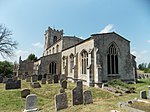Burton Coggles
Civil parishes in LincolnshireEnglish churches dedicated to St Thomas BecketSouth Kesteven DistrictUse British English from October 2014Villages in Lincolnshire

Burton Coggles (full name Burton-le-Coggles from Byrton-en-les-Coggles) is a small village and civil parish in the South Kesteven district of Lincolnshire, England. The population is included in the civil parish of Bitchfield and Bassingthorpe. The village is situated 7 miles (11 km) south from Grantham, and between the B1176 road and the East Coast Main Line.
Excerpt from the Wikipedia article Burton Coggles (License: CC BY-SA 3.0, Authors, Images).Burton Coggles
Manor Road, South Kesteven Burton Coggles
Geographical coordinates (GPS) Address Nearby Places Show on map
Geographical coordinates (GPS)
| Latitude | Longitude |
|---|---|
| N 52.82028 ° | E -0.54788 ° |
Address
Manor Road
Manor Road
NG33 4FP South Kesteven, Burton Coggles
England, United Kingdom
Open on Google Maps










